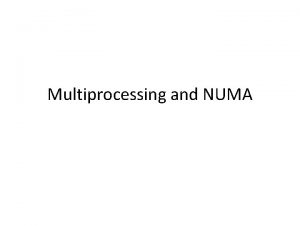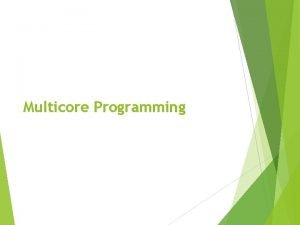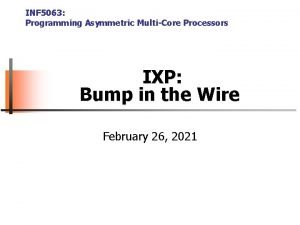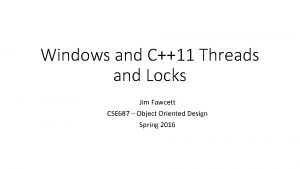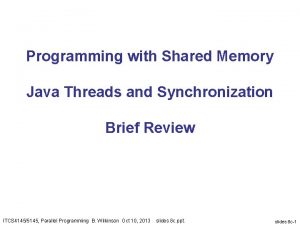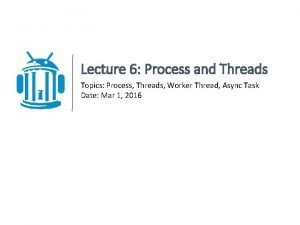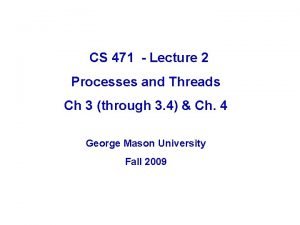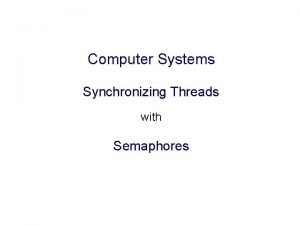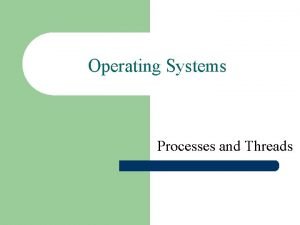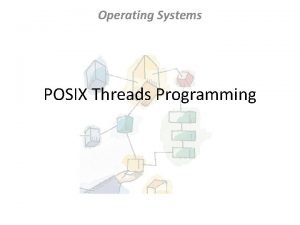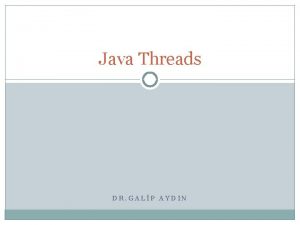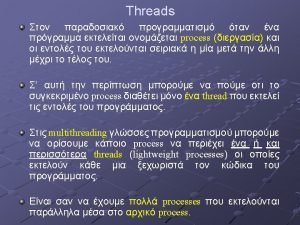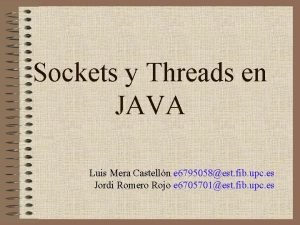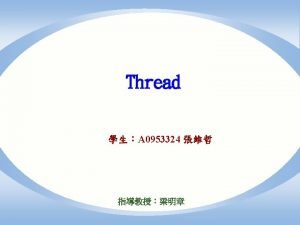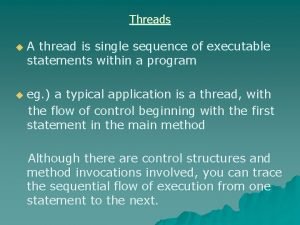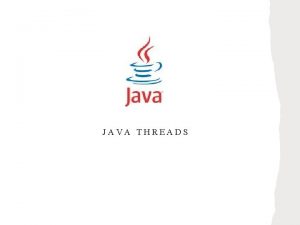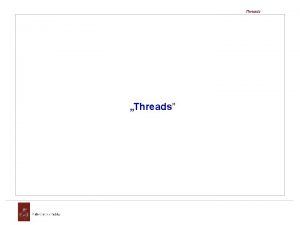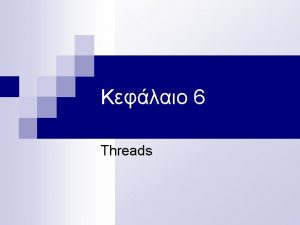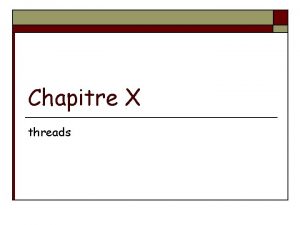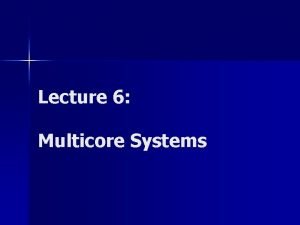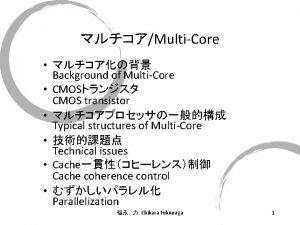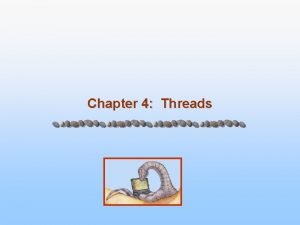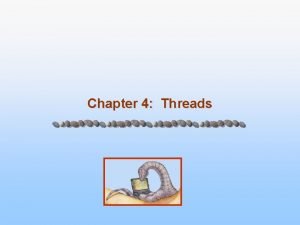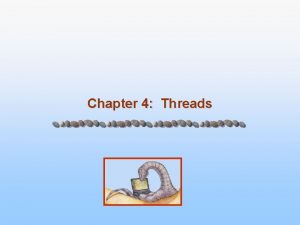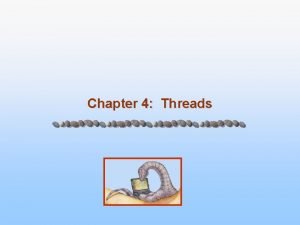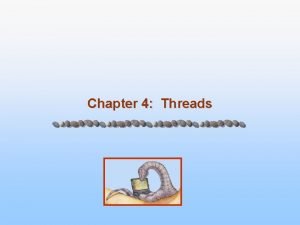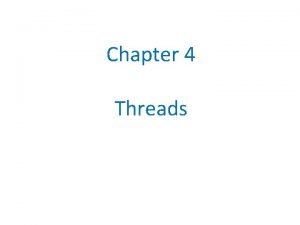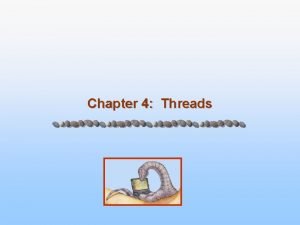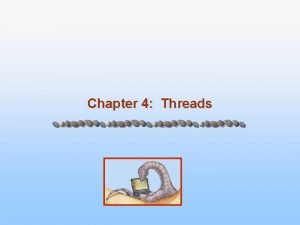Chapter 4 Threads Chapter 4 Threads Overview Multicore


































- Slides: 34

Chapter 4: Threads

Chapter 4: Threads • • Overview Multicore Programming Multithreading Models Thread Libraries Implicit Threading Issues Operating System Examples

Objectives • To introduce the notion of a thread—a fundamental unit of CPU utilization that forms the basis of multithreaded computer systems • To discuss the APIs for the Pthreads, Windows, and Java thread libraries • To explore several strategies that provide implicit threading • To examine issues related to multithreaded programming • To cover operating system support for threads in Windows and Linux

Motivation • Most modern applications are multithreaded • Threads run within application • Multiple tasks with the application can be implemented by separate threads – – Update display Fetch data Spell checking Answer a network request • Process creation is heavy-weight while thread creation is light-weight • Can simplify code, increase efficiency • Kernels are generally multithreaded

Benefits • Responsiveness – may allow continued execution if part of process is blocked, especially important for user interfaces • Resource Sharing – threads share resources of process, easier than shared memory or message passing • Economy – cheaper than process creation, thread switching lower overhead than context switching • Scalability – process can take advantage of multiprocessor architectures

Single and Multithreaded Processes

User Threads and Kernel Threads • User threads - management done by user-level threads library • Three primary thread libraries: – POSIX Pthreads – Windows threads – Java threads • Kernel threads - Supported by the Kernel • Examples – virtually all general purpose operating systems, including: – – – Windows Solaris Linux Tru 64 UNIX Mac OS X

Multithreading Models • Many-to-One • One-to-One • Many-to-Many

Many-to-One • Many user-level threads mapped to single kernel thread • One thread blocking causes all to block • Multiple threads may not run in parallel on muticore system because only one may be in kernel at a time • Few systems currently use this model • Examples: – Solaris Green Threads – GNU Portable Threads

One-to-One • Each user-level thread maps to kernel thread • Creating a user-level thread creates a kernel thread • More concurrency than many-to -one • Number of threads per process sometimes restricted due to overhead • Examples – Windows – Linux – Solaris 9 and later

Many-to-Many Model • Allows many user level threads to be mapped to many kernel threads • Allows the operating system to create a sufficient number of kernel threads • Solaris prior to version 9 • Windows with the Thread. Fiber package

Thread Libraries • Thread library provides programmer with API for creating and managing threads • Two primary ways of implementing – Library entirely in user space – Kernel-level library supported by the OS

Pthreads • May be provided either as user-level or kernel-level • A POSIX standard (IEEE 1003. 1 c) API for thread creation and synchronization • Specification, not implementation • API specifies behavior of the thread library, implementation is up to development of the library • Common in UNIX operating systems (Solaris, Linux, Mac OS X)

Pthreads Example • We will show a program that creates a new thread. – Hence a process will have two threads : • 1 - the initial/main thread that is created to execute the main() function (that thread is always created even there is no support for multithreading); • 2 - the new thread. (both threads have equal power) • The program will just create a new thread to do a simple computation. The new thread will get a parameter, an integer value (as a string), and will sum all integers from 1 up to that value. – sum = 1+2+…+parameter_value • The main thread will wait until sum is computed into a global variable. • Then the main thread will print the result. 14

Pthreads Example

Pthreads Example (Cont. )

• pthtread_attr_t attr represents thread attr. declaration including stack size and scheduling info. • set attr using pthtread_attr_init(& attr ) • argv[1] gives the integer val as cmd line arg(i. e. n) for summation function

Win 32 Threads • The technique for creating threads using the Win 32 thread library is similar to the Pthreads technique in several ways. • we must include the windows. h when using the Win 32 API. • Just as in the Pthreads version data shared by the separate threads —in this case, Sum—are declared globally (the DWORD data type is an unsigned 32 -bit integer. We also define the Summation function to be performed in a separate thread. This function is passed a pointer to a void, which Win 32 defines as LPVOID. The thread performing this function • sets the global data Sum to the value of the summation from 0 to the parameter • passed to Summation. O.

• Threads are created in the Win 32 API using the Create. Thread. O function and—just as in Pthreads—a set of attributes for the thread is passed to this function. These attributes include security information, the size of the stack, and a flag that can be set to indicate if the thread is to start in a suspended state. • In this program, we use the default values for these attributes (which donot initially set the thread to a suspended state and instead make it eligible • to be run by the CPU scheduler). Once the summation thread is created, the • parent must wait for it to complete before outputting the value of Sum, asthe value is set by the summation thread. Recall that the Pthread program had the parent thread wait for the summation thread using the pthread_j oin () statement. We perform the equivalent of this in the Win 32 APIusing the Wait. For. Single. Obj ect () function, which causes the creating threadto block until the summation thread has exited.

Windows Multithreaded C Program

Windows Multithreaded C Program (Cont. )

Java Threads • Java threads are managed by the JVM • Typically implemented using the threads model provided by underlying OS • Java threads may be created by: – Extending Thread class – Implementing the Runnable interface

Java Multithreaded Program

Java Multithreaded Program (Cont. )

Threading Issues • Semantics of fork() and exec() system calls • Signal handling – Synchronous and asynchronous • Thread cancellation of target thread – Asynchronous or deferred • Thread pools • Thread- specific data • Scheduler Activations

Semantics of fork() and exec() • Does fork()duplicate only the calling thread or all threads? – Some UNIXes have two versions of fork • exec() usually works as normal – replace the running process including all threads

Thread Cancellation • Thread Cancellation is the task of terminating a thread before it has finished. • For ex, if multiple threads are concurrently searching through a database and one thread returns the result, the remaining threads might be canceled. • Another ex, when a user presses a button on a web browser that stops a web page from loading any further. Often, a web page is loaded using several threads—each image is loaded in a separate thread. When a user presses the stop button on the browser, all threads loading the page are canceled. • Thread to be canceled is target thread • Two general approaches: – Asynchronous cancellation terminates the target thread immediately – Deferred cancellation allows the target thread to periodically check if it should be cancelled

Difficulty in Thread Cancellation • The difficulty with cancellation occurs in situations where resources have been allocated to a canceled thread or where a thread is canceled while in the midst of updating data it is sharing with other threads. • This becomes especially troublesome with asynchronous cancellation. • Often, the OS will reclaim system resources from a canceled thread but will not reclaim all resources. Therefore, canceling a thread synchronously may not free a necessary system-wide resource. • With deferred cancellation, in contrast, one thread indicates that a target thread is to be canceled, but cancellation occurs only after the target thread has checked a flag to determine if it should be canceled or not. • This allows a thread to check whether it should be canceled at a point when it can be canceled safely. • Pthreads refers to such points as cancellation points.

Why Thread Pools • Whenever server receives a request, it creates a separate thread to service the request. Whereas creating a separate thread is certainly superior to creating a separate process. • But multithreaded server has potential problems. • The first concerns the amount of time required to create thread prior to servicing the request and also discarding of thread once it has completed its work. • The second issue is: If we allow all concurrent requests to be serviced in a new thread, we have not placed a bound on the number of threads concurrently active in the system. Unlimited threads could exhaust system resources, such as CPU time or memory. • One solution to this issue is to use a thread pool.

Thread pool concept • The general concept of a thread pool is to create a number of threads at process startup and place them into a pool, where they sit and wait for work. • When a server receives a request, it awakens a thread from this pool—if one is available—and passes it the request to service. Once thread completes its service, it returns to the pool and awaits more work. • If the pool contains no available thread, the server waits until one becomes free.

Advantages of Thread Pools – Usually slightly faster to service a request with an existing thread than create a new thread – A thread pool limits the number of threads in the application(s) to be bound to the size of the pool. More suitable for the system that can not support large number of concurrent threads. • Windows API supports thread pools:

• A pointer to Pool. Function() is passed to one of the functions in the thread pool API, and a thread from the pool executes this function. One such member in thread pool API is : Queue. User. Workltem() , which is passed with 3 parameters: • LPTHREAD_START-ROUTINE Function—a pointer to the function that is to run as a separate thread • PVOID Param—the parameter passed to Function • ULONG Flags—flags indicating how the thread pool is to create and manage execution of the thread • An example of an invocation is: Queue. User. Workltem(&Pool. Function, NULL, 0); • This causes a thread from the thread pool to invoke Pool. Function() on behalf of the programmer. • In this instance, we pass no parameters to Pool. Function (). Because we specify 0 as a flag, we provide thread pool with no special instructions for thread creation.

Scheduler Activations • Both M: M and Two-level models require communication to maintain the appropriate number of kernel threads allocated to the application • Typically use an intermediate data structure between user and kernel threads – lightweight process (LWP) – Appears to be a virtual processor on which process can schedule user thread to run – Each LWP attached to kernel thread – How many LWPs to create? • Scheduler activations provide upcalls - a communication mechanism from the kernel to the upcall handler in the thread library • This communication allows an application to maintain the correct number kernel threads

End of Chapter 4
 Speedy transactions in multicore in-memory databases
Speedy transactions in multicore in-memory databases Multicore packet scheduler:
Multicore packet scheduler: Multiprocessor vs multicore
Multiprocessor vs multicore Multiprocessor programming
Multiprocessor programming And eat
And eat Cache craftiness for fast multicore key-value storage
Cache craftiness for fast multicore key-value storage Pxie-pcie8372
Pxie-pcie8372 Obs multicore
Obs multicore Asymmetric multicore processing
Asymmetric multicore processing Autosar multicore
Autosar multicore C11 threads
C11 threads Shared memory java
Shared memory java Conventional representation of external thread
Conventional representation of external thread Process and threads
Process and threads Flexible flat material made by interlacing yarns
Flexible flat material made by interlacing yarns Escalonamento de threads
Escalonamento de threads Process and threads
Process and threads Os threads
Os threads The vinaya pitaka is a sacred text of………….
The vinaya pitaka is a sacred text of…………. Needle like threads of spongy bone
Needle like threads of spongy bone Helps press seams in tubes like sleeves
Helps press seams in tubes like sleeves Golden thread process
Golden thread process Pintos priority scheduling
Pintos priority scheduling Advantages of threads in operating system
Advantages of threads in operating system Posix threads in os
Posix threads in os Threads java
Threads java Alternanthera red threads
Alternanthera red threads Forum.unity.com/threads/game-over.54735
Forum.unity.com/threads/game-over.54735 Threads fiji
Threads fiji Threads consumes cpu in best possible manner
Threads consumes cpu in best possible manner Sockets and threads
Sockets and threads Posix threads
Posix threads Forum.unity.com/threads/game-over.54735
Forum.unity.com/threads/game-over.54735 Threads vs processes
Threads vs processes Sequence diagram threads
Sequence diagram threads


